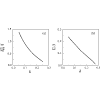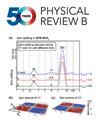Low-temperature T2 resistivity in the underdoped pseudogap phase versus T-linear resistivity in the overdoped strange-metal phase of cuprate superconductors
IF 3.7
2区 物理与天体物理
Q1 Physics and Astronomy
引用次数: 0
Abstract
The transport experiments demonstrate a dramatic switch from the low-temperature linear in temperature (-linear) resistivity in the overdoped strange-metal phase of cuprate superconductors to the low-temperature quadratic in temperature (-quadratic) resistivity in the underdoped pseudogap phase; however, a consensus on the origin of this unusual switch is still lacking. Here the resistivity in the underdoped pseudogap phase of cuprate superconductors is investigated using the Boltzmann transport equation. The resistivity originates from the electron umklapp scattering mediated by the spin excitation; however, the dominant contribution mainly comes from the antinodal umklapp scattering. In particular, a low-temperature scales with in the underdoped regime due to the opening of a momentum-dependent spin pseudogap, where is the minimal umklapp vector at the antinode. Moreover, this decreases with the increase of doping in the underdoped regime, and then is reduced to a very low temperature in the overdoped regime. In the underdoped regime, the resistivity is -quadratic at the low temperatures below , where the strength of the -quadratic resistivity weakens as the doping is raised. However, in the overdoped regime, the resistivity is -linear at the low temperatures above . The results in this paper together with the recent study on the resistivity in the overdoped regime therefore show that the electron umklapp scattering from a spin excitation responsible for the low-temperature -linear resistivity in the overdoped regime naturally produces the low-temperature -quadratic resistivity in the underdoped regime resulting from the opening of a momentum-dependent spin pseudogap.

铜氧化物超导体掺杂不足的伪间隙相的低温 T2 电阻率与掺杂过度的奇异金属相的 T 线性电阻率比较
输运实验证明,从铜氧化物超导体过掺杂奇异金属相中的低温线性电阻率(T-线性)到欠掺杂伪间隙相中的低温二次电阻率(T-二次)发生了戏剧性的转换;然而,人们对这种不寻常转换的起源仍缺乏共识。本文利用玻尔兹曼输运方程研究了铜氧化物超导体掺杂不足的伪间隙相中的电阻率。电阻率源于自旋激发介导的电子umklapp散射;然而,其主要贡献来自反正极umklapp散射。特别是,在掺杂不足的情况下,由于与动量相关的自旋伪缺口的打开,低温 Tscale 与 Δp2 成比例关系,其中 Δp 是反节点处的最小 umklapp 向量。此外,在欠掺杂体系中,随着掺杂量的增加,该 Tscale 会减小,然后在过掺杂体系中减小到非常低的温度。在掺杂不足体系中,电阻率在低于 Tscale 的低温下为 T 二次方电阻率,T 二次方电阻率的强度随着掺杂量的增加而减弱。然而,在过掺杂情况下,电阻率在高于 Tscale 的低温下呈 T-线性。因此,本文的研究结果与最近关于过掺杂体系电阻率的研究结果表明,在过掺杂体系中,自旋激发产生的电子umklapp散射导致低温T线性电阻率,而在欠掺杂体系中,自旋激发产生的电子umklapp散射自然会产生低温T二次方电阻率,这是因为与动量有关的自旋伪间隙打开了。
本文章由计算机程序翻译,如有差异,请以英文原文为准。
求助全文
约1分钟内获得全文
求助全文
来源期刊

Physical Review B
物理-物理:凝聚态物理
CiteScore
6.70
自引率
32.40%
发文量
0
审稿时长
3.0 months
期刊介绍:
Physical Review B (PRB) is the world’s largest dedicated physics journal, publishing approximately 100 new, high-quality papers each week. The most highly cited journal in condensed matter physics, PRB provides outstanding depth and breadth of coverage, combined with unrivaled context and background for ongoing research by scientists worldwide.
PRB covers the full range of condensed matter, materials physics, and related subfields, including:
-Structure and phase transitions
-Ferroelectrics and multiferroics
-Disordered systems and alloys
-Magnetism
-Superconductivity
-Electronic structure, photonics, and metamaterials
-Semiconductors and mesoscopic systems
-Surfaces, nanoscience, and two-dimensional materials
-Topological states of matter
 求助内容:
求助内容: 应助结果提醒方式:
应助结果提醒方式:


